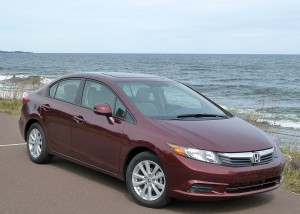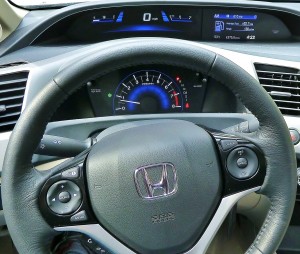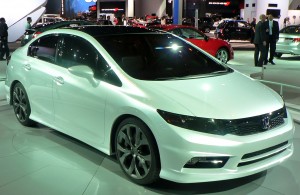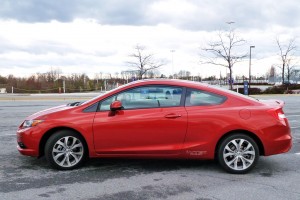Honda winners include new Civic, Indy 500
By John Gilbert
The end of April was a good time to launch the all-new, ninth-generation 2012 Honda Civic, although the end of May might have been even better. The end of May is time for the Indianapolis 500, which gathers an annual turnout of up to 400,000 spectators to the Indianapolis Motor Speedway, and millions more worldwide television viewers.
The 2011 Indianapolis 500 is the 100th running of the classic oval-track race, and while single-seat, open-wheel missiles traveling 227-mile-per-hour laps around the 2.5-mile track may seem distant to something as basic as a new compact car, the parallel is perfect. A good bet to be the top-selling compact car for the coming year would be the Civic. An even better bet to win the Indy 500 would be to pick — Honda.
That one is a cinch, because all 33 entries in the Indy 500 will be powered by Honda engines. Every single one. It is a testimony to Honda’s engineering and technology that no other company can compete with Honda in the world’s fastest race. Race reporters seem to take Honda’s participation for granted, and very few other people — including in the automotive media — seem to be aware how totally Honda dominates the Indy Car race scene. For decades, Honda’s technical superiority is only exceeded by the company’s inability to promote its superiority. Maybe that’s why nobody made the connection to trumpet the combined facts of Honda’s success in a race in which durability and efficiency are as important as speed, while introducing the Civic, the real-world icon of Honda’s applied engineering efficiency.
Unlike Honda’s monopoly at Indy, the Civic faces stiff competition, the stiffest ever in the subcompact segment since the Civic was introduced to the U.S. as a 1973 model. Traditional rivals, such as the Toyota Corolla, Nissan Sentra, and Mitsubishi Lancer, have been joined by the Mazda3 and in 2011 by a new Hyundai Elantra, Chevrolet Cruze, and Ford’s new Focus and even the smaller Fiesta.
Nonetheless, the Civic seems pretty well set to be top seller in the segment. The styling remains on the leading edge outside, and is outstanding inside, with driver’s instruments and ergonomics that are a model for the industry. The seats are good and supportive, and rise to excellent in the sporty Si version. The shape of the car enhances visability down the steeply raked hood in all models, and while looking ahead, you find it easy to also see a large digital speed readout, on a strip of electronic instrumentation just above the thick and comfortably grasped steering wheel. Look above the wheel for your speed, and looking through the wheel gives you the large tachometer and other instruments, plus a new information panel to the right that can be changed to various preferences.
It’s all very race-car like, reminding us of going back to the 1990 era, when Honda dominated Formula 1 Grand Prix racing in the hands of the late Ayrton Senna. In Formula 1, or Indianapolis racing, a driver doesn’t have a lot of time to be studying instruments, so a glance at a digital tach or speedometer must suffice. It was back then that Honda adapted its technical expertise from Formula 1 onto its production models, including a generation of Civics that ran from 1991-1995. With variable valve-timing, double-wishbone suspension, and all-wheel disc brakes, the Civic of that generation stood as the best until the 2006 model rolled out. If you get on CarSoup and find a clean 1991-95 Civic EX, it would be a perfect second family car or an offspring’s first car, regardless of miles.
No other car compares to the array of five or six different models offered by the Civic. They range from the DX that starts at $15,605 ($16,405 for the automatic version), to the LX at $17,655/$18,455, the EX at $19,705/$20,505, with the top-level version EX with navigation and leather interior for $23,455. A specially-modified HF model, tweaked for higher mileage, is priced at $19,455, and attains EPA highway estimates of 41 mpg, compared to 39 for the rest of the fleet’s 1.8-liter figures. In
addition, a sportier high-performance Si model is again offered, ranging from $22,205 to $23,905, depending on whether you choose a coupe or sedan. The Si has a larger engine, and a 6-speed stick rather than the 5-speed offered in other coupes and sedans. Those stick shifts are smooth and precise in feel and engagement.
The Civic Hybrid is upgraded considerably, switching from a nickel-metal hydride battery pack to lithium-ion, which is more compact in size and far more efficient in developing and holding electrical power. Paired with the 1.5-liter engine from the smaller Fit, the added boost brings the horsepower up to a mere 110, with 127 foot-pounds of torque, which equates to more torque at fewer RPMs. Spread through a continuously-variable transmission, the car moves with adequate power, and it has improved EPA estimates of 44 miles per gallon, whether city or highway. A Civic Hybrid base price is $24,050, and with navigation and leather, can rise to $26,750.
If that’s not enough, a natural gas version of the Civic will be coming as a production model this fall.
Design of the new Civic is not an enormous departure from the current model, which made a total and stunning design makeover and won the 2006 North American Car of the Year award for design, interior space, performance, price, fuel economy, and diversity of models. The new car has a different look from the front, taking on some of the Insight’s lower grille appearance, and it rounds off the current model’s attractive wedginess into a more rounded shape. Overall length remains the same, while the wheelbase is shortened by a couple of inches, which helps agility a bit and helps interior room quite a bit. The interior remains creatively arranged, with a dashboard that combines a personal cockpit-style for the driver, and falls away gracefully to give the front passenger surprising spaciousness.
At the car’s introduction, in Washington, D.C., we drove from our Georgetown hotel out to FedEx Field, the Redskins NFL stadium, in a loaded EX-L model, then tried out the rest of the fleet. A steady rain finally let up so we could try a couple of cone-lined, parking-lot courses. A couple of Si Coupes proved their potency and handling there. The larger 2.4-liter four-cylinder, its 16 valves driven by dual overhead-camshafts, revs freely and is well-matched to its 6-speed manual transmission. Upgraded suspension settings and larger 17-inch wheels give the Si firmer and more stable cornering capabilities, and further put to rest the common misconception that front-wheel-drive cars aren’t as fun to fling around a track as rear-drivers. In fact, on the well-moistened autocross course, a rear-drive car would have left the choice of letting up or spinning out in places where you could hammer the throttle and simply steer the Si around the curve. The Si adds distinctive sound from the exhaust tuning, and improves on the already good Civic seats with added side bolsters in the cushion and backrest.
The Si’s 201 horsepower peak at 7,000 RPMs and 170 foot-pounds of torque at 4,300 revs, up from the 140 horses at 6,500 and 128 foot-pounds at 4,300 for the normal 1.8 liter models. However, at 2.4 liters, the much larger engine drops Si fuel economy to 22 city/31 highway from the normal Civic’s 28 city/39 highway.
The 1.8-liter four, with a single overhead cam smoothly operating four valves per cylinder, remains the Civic mainstay, except for the Si and Hybrid. On a milder handling circuit, the Civic felt predictable, although it leaned a lot more in sharper curves than the Si, which was to be expected. Honda parked a new Hyundai Elantra nearby for comparison purposes, and I must say the Korean competitor had good power and actually seemed to lean less in hard cornering.
A Civic Hybrid mileage test on normal roads sent me out with James Bell, a good friend from Los Angeles, as codriver. The roadways leaving FedEx Field are as complicated as the folks downtown trying to solve the federal budget. No matter. We had zeroed the odometer and kept driving, up and down some suburban roadways until we reached the specified mileage. My fuel economy was 44.1, which I thought was OK, but a bit disappointing, because I light-footed it all the way. James drove similarly and attained 53.7 miles per gallon — an excellent reading that was third best of all. An engineer explained the discrepancy as the battery being depleted when we first got in the car, and my session recharged the battery pack, which provided more free power and thus better fuel economy during my partner’s run.
The new Civic has been improved by increasing the amount of high-strength steel to 55 percent, making the car lighter yet stronger, with a 10-percent increase in torsional rigidity. More safety technology helps the driver handle situations better. And some high-tech additions enhance that safety. Motion-Adaptive EPS coordinates with the standard antilock brakes and traction and stability controls, as well as with electric power steering to act as soon as the computer detects instability, to improve directional stability in cornering. Problems in curves come down to oversteer or understeer, and are worsened in slippery situations. Turning the wheel too much for the curve (oversteer) is detected and braking force is applied to the outside wheels, helping the driver stay on the proper trajectory. Not turning the wheel enough for a curve (understeer) is similarly offset with the Civic system suppressing engine torque to the inside wheel while also braking the inside wheels to help the driver negotiate the curve.
With such technology, and having models with capabilities ranging from the Hybrid’s real-world 50-plus mpg, to the speed, quickness and agility of the Si, and satisfactory everyday performance out of the other models in between, the Civic seems primed to hold its place atop the compact segment.
The Civic, be assured, is better than the puzzling advertising campaign from RPA, Honda’s ad agency for three decades. Television ads lacked anything resembling cleverness for the current 2011 models, but they’ve hit bottom now. First, showing ghoulish zombies and furry critters eager to drive the new Civic is supposed to indicate that you should join right in with those zombies and animated creatures in desiring a Civic. Another new campaign features the catch-phrase “To Each Their Own.” The proper phrase is “to each his own,” where “his” is accepted for gender-neutral coverage of all humanity, but RPA apparently has decided that striving for political and gender correctness overrides the need for grammatical and proper English usage.
At the post-introduction press questioning, there was some fear that the car itself could falter to meet the low-level ad scheme. Someone asked why there was only a 5-speed stick and 5-speed automatic. Honda officials said that their market research indicated that buyers didn’t care. One engineer said that combining optimum fuel economy and value, the technology to go to a 6-speed wasn’t necessary. Furthermore, there are no steering wheel paddles for manually controlling the automatic, to which the answer was that market research showed buyers didn’t use paddles. As for the stick, the engineer said that they worked hard to get the gear ratios correct to balance fuel economy and driveability.
If there had been a gong, it would have sounded right then — three times, just for the perceived value of the competition. The new Elantra offers a 6-speed in stick and automatic, the Focus and Fiesta automatics are not only 6-speed but are direct-sequential gearboxes as well, and even the Cruze offers a choice of 6-speed stick or 6-speed automatic. The decision to stay with 5-speeds for both manual and automatic leaves the Civic with last-generation technology. Also, the Elantra, the Cruze, the Mazda3 and others offer manual gates or paddles on their automatics, and whether buyers use them or not, by lacking such manual control the Civic falls short again.
Honda’s suspension engineers always have been outstanding, based on how the Civic and other Hondas handle. The independent suspension is good, and the new Civic has MacPherson struts up front and multilink geometry at the rear, both reinforced by stabilizer bars. It does the job, but as I felt the EX model lean in cornering, I couldn’t help but recall my favorite 1991-95 Civic EXes that had, standard, double-wishbone suspension on all four corners. It was right off the race car technology, and while it was expensive, it also was superb — part of what convinced me of Honda’s superior technology.
Those 1991-94 Civic EXes also had 4-wheel disc brakes, standard, and now Honda tries to suggest that using rear drum brakes with the front discs on the DX, LX, HF, Hybrid, and the natural gas models is justified. Only the Si and EX models get 4-wheel discs. I anticipate technical advancements from Honda, and such decontenting is not what I expect from my technical leader.
In addition, claiming an all-new engine gives he Si more horsepower is a bit misleading. The 2.4 engine has been used in Hondas for years. I know well of a 1994 Prelude VTEC with that engine, and it more recently powers the larger Accord sedans. Stuffing a larger-displacement engine into a smaller car seems more General Motors than Honda, which has built its reputation on over-achieving technology from smaller engines to run with larger competition. With nearly a 25 percent increase in displacement over the current 2.0-liter four, adding only 4 horsepower wouldn’t make me eager to give up that high-revving jewel of a 2.0.
The pluses far outweigh any such minuses, particularly from the ad agency’s phrase “To Each Their Own.” I thought maybe I was being too critical about it until the New York Auto Show, when Honda executive vice president John Mandel, reading a teleprompter to avoid overlooking any pertinent facts, finished his presentation by saying: “…To Each His Own.” When asked if the teleprompter actually said “his” or “their,” Mandel laughed and refused to say. He did, however, point out that his wife is an English teacher.
It was reassuring to know that literate people can rise above bad advertising. It would also be reassuring to know that Honda technology can rise above such modern twists as using market research to rationalize decontenting. Now Honda has to find a way to prevent its semi-literate catch-phrase from sending English teachers all over the country to one of the Civic’s hot, new competitors. That specific repercussion might be a sure-thing bet. Although not as certain as that the Indianapolis 500 winner will drive to the finish line in a Honda.
Comments
Tell me what you're thinking...
and oh, if you want a pic to show with your comment, go get a gravatar!







 John Gilbert is a lifetime Minnesotan and career journalist, specializing in cars and sports during and since spending 30 years at the Minneapolis Tribune, now the Star Tribune. More recently, he has continued translating the high-tech world of autos and sharing his passionate insights as a freelance writer/photographer/broadcaster. A member of the prestigious North American Car and Truck of the Year jury since 1993. John can be heard Monday-Friday from 9-11am on 610 KDAL(www.kdal610.com) on the "John Gilbert Show," and writes a column in the Duluth Reader.
John Gilbert is a lifetime Minnesotan and career journalist, specializing in cars and sports during and since spending 30 years at the Minneapolis Tribune, now the Star Tribune. More recently, he has continued translating the high-tech world of autos and sharing his passionate insights as a freelance writer/photographer/broadcaster. A member of the prestigious North American Car and Truck of the Year jury since 1993. John can be heard Monday-Friday from 9-11am on 610 KDAL(www.kdal610.com) on the "John Gilbert Show," and writes a column in the Duluth Reader.